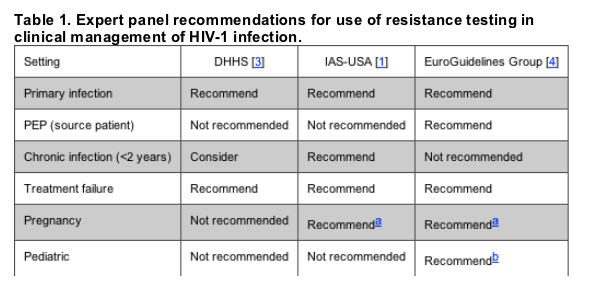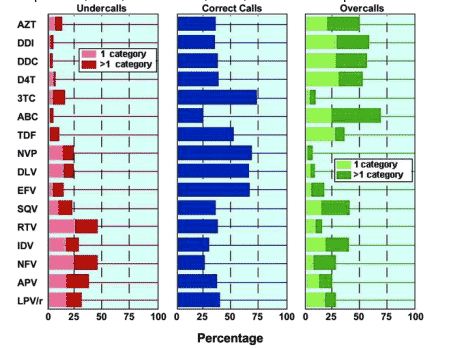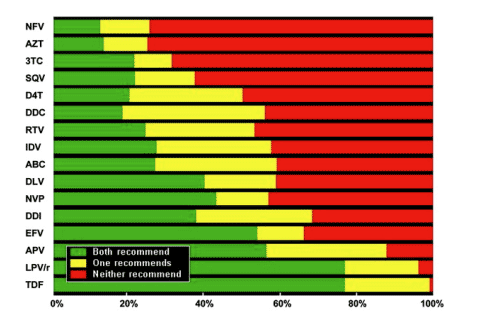| |
Incorporating Drug-Resistance Measurements into the Clinical Management of HIV-1 Infection, Andrew Zolopa, MD
|
| |
| |
The Journal of Infectious Diseases 2006;194:S59-S64
Andrew R. Zolopa
Department of Medicine, Stanford University, Stanford, California
Abstract
Testing for resistance to antiretrovirals is considered to be standard of care and is widely used in the management of human immunodeficiency virus (HIV)-infected persons. Despite the widespread use of resistance testing, the clinician still faces a number of challenges when applying these technologies in the optimal management of antiretroviral therapy. Both genotype and phenotype tests require interpretation, and available interpretative algorithms for genotypes and resistance cutoffs for phenotypes are incomplete and evolving. Even experts in HIV resistance do not completely agree in their interpretation of genotypes. Moreover, discordant results between genotypes and phenotypes are a common source of confusion when both tests are used to evaluate resistance in a patient. Finally, newer indicators, such as replication capacity, are clinically available and appear to have prognostic value, but how this in vitro measure should be used in the management of antiretroviral therapy remains to be fully defined.
Testing for resistance to antiretrovirals is considered to be standard of care and is widely used in the management of HIV-infected persons. Current guidelines from expert panels recommend resistance testing in the setting of treatment failure and, more recently, have recommended that persons who have been infected for <2 years have resistance testing before initiating antiretroviral therapy [1].
Despite the widespread use of resistance testing in clinical practice, there remain a number of challenges to the clinician in applying these technologies to optimally manage the treatment of HIV infection. Genotype testing requires interpretation, and the results can often be complex and confusing to even highly experienced clinicians. Furthermore, the interpretative algorithms are continually evolving as our knowledge of drug resistance expands, and there are a number of different algorithms available to clinicians that do not always provide the same interpretation for a given genotype result [2].
Phenotype testing provides to the clinician a result that is more familiar and less complex than genotype testing, but it, too, requires an interpretation to be useful in the management of antiretroviral treatment. The phenotype cutoffs that define when a virus has reduced susceptibility to a particular drug are, like the genotype algorithms, still evolving and are as of yet incomplete.
Adding to the complexity of resistance testing in clinical practice is genotype-phenotype discordance. When both tests are used to optimize treatment decisions, many times the results appear to be in conflict with one another-the genotype is interpreted as showing resistance, whereas the phenotype does not show resistance, or vice versa. Moreover, mutational interactions can lead to phenotypic "hypersusceptibility," which appears to have clinical relevance. Finally, measurements of viral replication capacity are now available to the clinician, but the role this in vitro measure should play in the management of patients remains to be fully defined. Here, I review the challenges facing the clinician in using these cutting-edge technologies in the management of antiretroviral therapy.
RESISTANCE TESTING GUIDELINES: EXPERT PANEL RECOMMENDATIONS
Several different panels of experts have issued guidelines on the optimal use of resistance testing (table 1). All panels recommend the use of resistance testing in the setting of treatment failure, for which several randomized controlled studies have demonstrated improved virological outcomes, compared with those in the absence of resistance testing, when changing to a new antiretroviral regimen.

Resistance testing remains a useful tool even in the setting of picking a salvage therapy-a treatment regimen for a highly treatment-experienced patient who has experienced failure of multiple prior regimens and has multidrug-resistant HIV-1 infection. In this situation, the resistance test allows the clinician to optimize a regimen largely made up of partially active drugs. This benefit is of particular importance when an agent of a new class is being incorporated into the salvage regimen, as is illustrated in the recently published trials incorporating enfuviritide into salvage regimens [5]. In the TORO (T20 vs. Optimized Regimen Only) studies, virological response was highly correlated with the number of active drugs in the optimized background therapy, as determined by baseline resistance testing in the group receiving enfuviritide as well as in the control arm.
The International AIDS Society-USA panel now recommends that resistance testing also be performed for patients who are estimated to have been infected for <2 years [1]. This is based on the overall prevalence of drug-resistant HIV being transmitted in these patients and the emerging data suggesting that transmitted resistance is detectable for up to 2 years and perhaps longer [6].
THE EVOLUTION OF DRUG RESISTANCE DURING A FAILING ANTIRETROVIRAL REGIMEN
For some time, it has been clear that patients who have initial virological breakthrough while receiving a particular antiretroviral regimen do not necessarily have resistance to all of the drugs in that failing regimen. At first, this seemed counterintuitive to many clinicians, who asked "How can a regimen be failing if not all drugs in that regimen are failing?" The likely answer is that only 1 or 2 active drugs are often not sufficiently potent to maintain high levels of virus suppression, and, therefore, rebound viremia results. Drugs in the regimen that have a relatively "low genetic barrier to resistance" (in which only a single-amino acid substitution results in loss of antiviral activity), such as the nucleoside RT inhibitors (NRTIs) lamivudine and emtricitabine or the nonnucleoside RT inhibitors (NNRTIs), will select for resistance rapidly in the early phase of virological breakthrough, whereas other drugs, such as zidovudine and the protease inhibitors (PIs), will have relatively slower evolution of drug resistance, because of the requirement of accumulation of multiple amino acid substitutions to confer high-level resistance. This means that clinicians may be able to recycle certain elements of a failing regimen if resistance testing is performed early enough in the course of virological failure.
Boosting the PI concentration by use of small doses of another PI, such as ritonavir, appears to further protect the PI component of the regimen from the early development of resistance in failing regimens. This was first demonstrated in the Abbott 863 trial, in which ritonavir-boosted lopinavir was compared with unboosted nelfinavir. The investigators showed that there was more PI resistance at initial confirmed virological failure in the nelfinavir arm than in the lopinavir arm, and this protective effect seemed to extend to the other drugs in the treatment regimen, such that lamivudine resistance was detectable in 29% of the nelfinavir arm, compared with 7% in the lopinavir arm, after 96 weeks of follow-up [7]. This boosting effect can be seen as analogous to a "postantibiotic effect," in which the boosted PI continues to exert an effect that protects against more-rapid development of resistance, much as we see with certain antibiotics exerting a therapeutic effect after treatment with the drug has been stopped. This boosting effect is not unique to lopinavir-it has been demonstrated for boosted fos-amprenavir and, more recently, has been reported for boosted saquinavir [8, 9].
INTERPRETING GENOTYPES: THE ROLE OF THE "EXPERT"
Merigan's group conducted the first randomized controlled trial of resistance testing in the setting of treatment failure-the "GART (genotype antiretroviral resistance testing) study"-which showed improved short-term virological response when treatment was guided by resistance testing over that seen with no resistance testing [10]. Since that time, there has been controversy about the relative role of resistance testing versus the expert advice that usually accompanies the resistance test results in improving outcomes. Patients who had resistance testing also had the benefit of an expert's opinion that accompanied the test result.
The relative role of additional expert advice compared with practitioner-only interpretation of genotype testing results was clearly demonstrated in the Havana trial [11]. Using a factorial design, the investigators randomized patients undergoing failing antiretroviral regimens to either receive or not receive genotype testing and to either receive or not receive expert advice. The group who had both genotyping results and expert advice had the best outcomes (69% of this group achieved a virus load of <400 copies/mL at 24 weeks), but the group who had expert advice alone had outcomes that were comparable to those of the group who had genotyping alone (49% compared to 46% achieving <400 copies/mL, respectively).
So, given the complexity of interpreting resistance test results, it appears that having an expert help guide the treatment decisions improves treatment outcomes. However, one wonders how good the experts are at interpreting genotypes and how much agreement there is in the interpretation of genotypes among experts worldwide. We answered these questions in the "GUESS" study, in which we asked a panel of 12 international resistance experts to interpret 50 complex genotypes, giving them only the changes from an HIV-1 consensus sequence [12].
The experts showed various levels of accuracy at predicting the phenotype fold change from the given genotype for the 16 antiretrovirals commonly in use. For most drugs, levels of accuracy were roughly 25%-40%. The exceptions were the NNRTIs and lamivudine, for which levels of accuracy reached 75%. Levels of agreement between the experts were also about 40% for most of the drugs (figure 1). Despite these relatively low levels of agreement, the expert panel agreed on treatment recommendations about 80% of the time (figure 2). Thus, one can conclude that experts are not terribly accurate in translating genotypes into phenotypes or into expected drug activity levels, but there is broad agreement in making treatment recommendations based on the genotype-which, in the end, is what most clinicians seek from a genotype interpretation algorithm.
Figure 1. Prediction of measured phenotype fold-change categories (600 predictions per drug). "Correct calls" gives the percentage of expert-predicted phenotype fold-change category that corresponded to actual fold-change category measured by Antivirogram phenotype. "Undercalls" are the percentage of predictions that were >1 fold-change category lower than the actual measured fold-change category, and "overcalls" are the predicted fold-change categories that were 1 fold change above actual fold-change category [12]. ABC, abacavir; APV, amprenavir; AZT, zidovudine; D4T, stavudine; DDC, zalcitabine; DDI, didanosine; DLV, delavirdine; EFV, efavirenz; IDV, indinavir; LPV/r, lopinavir + ritonavir; NFV, nelfinavir; NVP, nevirapine; RTV, ritonavir; SQV, saquinavir; 3TC, lamivudine; TDF, tenofovir disoproxil fumarate.

Figure 2. Concordance of treatment recommendations based on genotype result. Bars give percentages of consensus among all pairs of experts in recommending (green) or not recommending (red) a particular antiretroviral drug for a given genotype. Yellow bars give the percentage of recommendations in which there was disagreement between expert pairs in their recommendation for a given genotype result [12]. ABC, abacavir; APV, amprenavir; AZT, zidovudine; D4T, stavudine; DDC, zalcitabine; DDI, didanosine; DLV, delavirdine; EFV, efavirenz; IDV, indinavir; LPV/r, lopinavir + ritonavir; NFV, nelfinavir; NVP, nevirapine; RTV, ritonavir; SQV, saquinavir; 3TC, lamivudine; TDF, tenofovir disoproxil fumarate.

INTERPRETING THE PHENOTYPE
As mentioned above, the interpretation of the phenotype comes in defining the cutoffs for drugs. The antiretroviral drug concentration required to inhibit a patient's virus strain, compared with that required to inhibit a reference virus strain without antiretroviral drug resistance, is normally expressed as a fold change in IC50 at which the virus becomes less susceptible to a given drug. There are 2 potentially important cutoffs for each drug: The lower cutoff would define when the susceptibility begins to decline but the drug still has partial activity, and the upper cutoff would be the fold change at which all drug activity is lost. These so-called "clinical cutoffs" have not been defined for all of the antiretrovirals in use today, and, therefore, the clinician depends on so-called "biological cutoffs," which are simply based on the variation in fold changes seen in populations without drug resistance. If a patient's sample is outside that distribution, it is considered to have reduced susceptibility.
The number of drugs with clinical cutoffs is small because of the challenges inherent in defining these cutoffs. For most drugs, resistance and response is a continuum, and, therefore, any cutoff is by its very nature somewhat arbitrarily drawn. Second, most drugs are used in combination with other drugs, so teasing out the impact of a particular drug is difficult. Nonetheless, progress is being made here as well. The PhenoSense assay now reports clinical cutoffs for the NRTIs abacavir, tenofovir, didanosine, and stavudine and for boosted lopinavir, indinavir, atazanavir, and tipranivir, with more to follow [13]. The Virco Antivirogram assay also has clinical cutoffs for lopinavir, abacavir, and tenofovir [14]. Having clinical cutoffs should improve the clinical utility of phenotype testing, particularly for patients with complex genotype patterns.
PHENOTYPE/GENOTYPE DISCORDANCE
Because both phenotype and genotype are imperfect determinations, many clinicians order both to try to bring all information to bear when making the critical decision about a patient's new antiretroviral regimen. Although there are no clinical trials that support the use of both genotyping and phenotyping together to improve outcome, this approach seems to have clinical merit, particularly in the setting of highly treatment-experienced patients with multidrug-resistant HIV-1 infection. The problem with using both tests is discordant results; that is, the genotype appears to say one thing and the phenotype the opposite. Thus, the risk of having more information is that there may be more confusion rather than clarity. Discordance occurs commonly when both tests are ordered; the results are discordant about 25%-30% of the time (data on file, Monogram). The causes of discordance have recently been reviewed, and knowing these causes can help the clinician make sense of the complexity [15].
HYPERSUSCEPTIBILITY
Hypersusceptibility can be seen as the opposite of resistance or reduced susceptibility. Here, the patient's virus requires a lower concentration of drug to inhibit growth than does the control virus. This in vitro phenomenon has been shown to have clinical relevance most clearly for the NNRTIs. Several cohort studies and clinical trials have demonstrated that patients with an HIV strain that is hypersusceptible to NNRTIs have a better short-term virological response to a NNRTI-based regimen than do those patients who harbor only strains susceptible to NNRTIs [16].
It has been shown that NNRTI hypersusceptibility is related to NRTI-associated resistance mutations, but the relationship is complex and difficult to predict from a genotype [17, 18]. Therefore, although it is not clear how a clinician could incorporate knowledge of hypersusceptibility into a treatment plan, phenotype has the advantage over genotype as a direct measure of this phenomenon.
REPLICATION CAPACITY AND VIRAL FITNESS
Beyond phenotype and genotype tests, clinicians are now also faced with the question of how to incorporate measures of viral fitness into their treatment strategies for HIV-infected patients-particularly for those patients for whom a fully suppressible regimen is not possible. Viral fitness is an in vivo phenomenon that includes the effect of antiretrovirals, immune suppression, and other factors. Although we do not have a true viral fitness measurement, replication capacity, an in vitro measurement, has been shown to correlate with in vivo measures of fitness [19]. Grant et al. [20] showed that the rate of disappearance of resistant HIV during a treatment interruption correlated with the replication capacity of that virus compared with that of the wild type. Furthermore, several recent studies have suggested that replication capacity has potentially important prognostic value that is independent of virus load testing and resistance testing.
Barbour et al. [21] have shown that CD4+ T cell counts after seroconversion were inversely correlated with replicative capacity in acutely infected patients. Haubrich [22] has demonstrated that patients who switched to a new antiretroviral regimen but did not achieve full virus suppression while treated with the new regimen had better virus load responses when the replicative capacity was lower [22]. Most recently, Daar et al. [23] have shown that lower replication capacity predicts slower declines in CD4+ T cell count and less progression to AIDS in a group of patients with hemophilia who received minimal antiretroviral treatment.
Taken as a whole, these studies suggest that the measurement of replicative capacity has certain prognostic power independent of other measures available to the clinician; however, it remains unclear how the clinician should best incorporate this measure into clinical practice.
CONCLUSIONS
The management of HIV infection becomes increasingly complex and specialized as more drugs become available to treat patients and more complex tests become available to manage the drugs. Resistance tests are now the standard of care, and a clinician must have a solid understanding of the tests, including their limitations, to be considered qualified to manage HIV-infected persons. Although the technology behind resistance testing is reliable and fairly standardized by this point, the interpretation of resistance testing is still evolving. Incorporating new measures, such as replicative capacity, to optimize management will continue to challenge even the most expert clinician. In the end, all tests need to be interpreted in the clinical context of the patient, which includes assessment of the treatment history, virus load and CD4+ T cell profile, adherence patterns, and toxicities and other adverse events. It is only in this broader context that optimal use of the tests can be achieved.
|
|
| |
| |
|
|
|